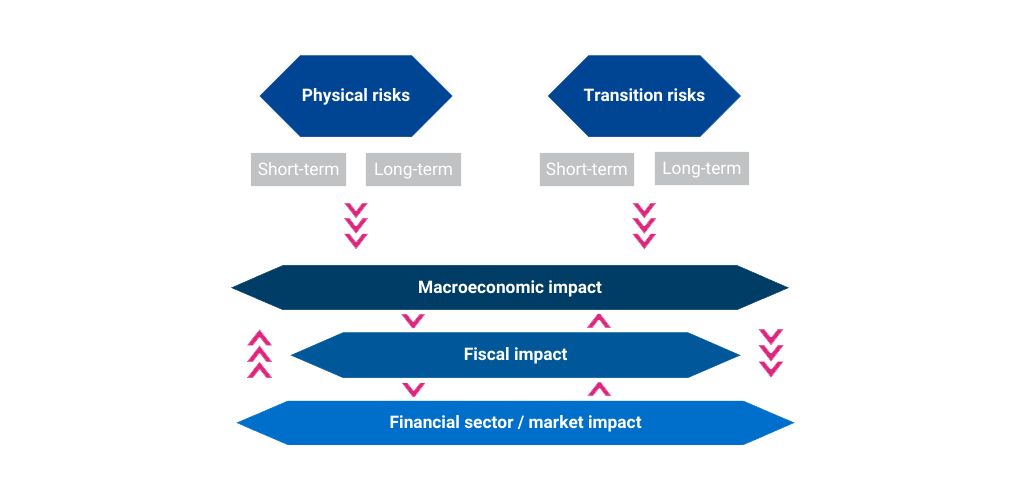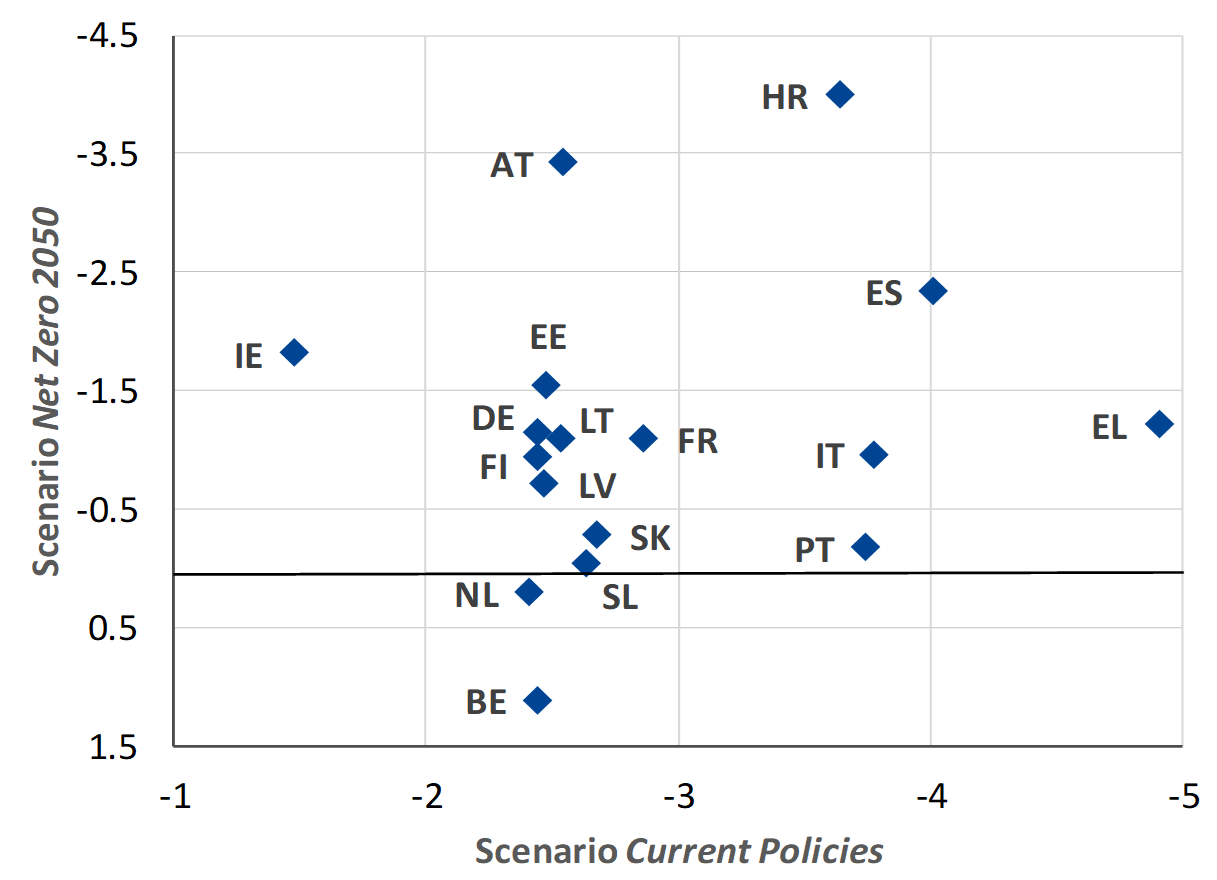Assessing climate risks at the ESM
In a world of ever-evolving risks, the challenges climate change poses have moved into the spotlight. The risks we face are not just to the environment and humankind, but also to financial stability. Both climate events and efforts to mitigate their risks can impact financial market conditions and long-term economic prosperity.
Given its mission to safeguard financial stability and provide support to euro area countries in financial distress, we explore why integrating climate risks into the European Stability Mechanism (ESM) risk monitoring framework is imperative and how the institution is navigating this complex issue.
Relevance of climate risks for financial stability
Climate change triggers weather shocks like heatwaves and floods, which can wreak havoc on places that are insufficiently prepared for the intensity and frequency of such events. Such physical risks can entail capital and productivity losses in addition to hardships for people. It takes time and resources to adapt, if even possible, to rising temperatures and sea-levels. These costs can place a financial burden on the countries affected.
In response, many governments and supranational entities are developing policies to curb climate change by incentivising households and firms to cut greenhouse gas emissions. This decarbonisation process creates transition risks, as uncoordinated and sudden policy changes can strand some assets and disrupt production networks, resulting in a surge of job losses and threatening financial stability.
Understanding the impact of climate-related events and the potential for a future rapid, non-linear impact is essential to preventing crises. Both physical and transition risks can impair a country’s capacity to repay or roll-over its debt and derail economic support programmes set up to solve financial crises.
Physical climate risks are more pronounced for southern euro area countries[1], which include several that received ESM support during earlier crises. When countries face both climate change and economic vulnerabilities, such as high debt-to-GDP ratios, integrating climate risk assessment is particularly relevant for the ESM.
Inaction the biggest risk
The ESM stays abreast of the latest risk analysis methods by engaging with peer institutions and leading academics, bolstering knowledge through close relationships with member states. Combining all the information, the ESM has adopted a structured approach to climate risks, distinguishing between macroeconomic, fiscal, financial sector, and market effects while also studying their interactions and separating short- from long-term considerations (see Figure 1).
Short-term risks include extreme weather events or abrupt changes in market regulations and conditions that affect carbon-intensive industries, such as the energy industry or transportation, resulting in asset losses and production disruptions. We examine how these adverse macroeconomic effects impair public finances, including any additional budgetary impact triggered by ad-hoc policy responses intended to combat climate change. Figure 2 illustrates how an unusually harsh drought would translate into additional public expenditure. We also consider how these shocks can translate into impaired financial assets and rising insurance costs. Conversely, we also investigate how government policies and better developed insurance markets could mitigate these adverse shocks and contribute to climate adaptation.
Figure 2: Unusually harsh droughts increase public spending, resulting in short-term fiscal costs
(in % of GDP)
Notes: Estimated impact on public spending of an increase in the prevalence of droughts that is three standard deviations above average conditions (this would correspond to drought conditions that are marginally harsher than the worst conditions observed over the past four decades). Data is not available for the Netherlands and costs are estimated to be zero for Ireland.
Source: Akyapi et al. (2022)
Long-term risks mainly stem from uncertainty around policy choices and the general difficulty in accurately quantifying climate risks. Scenario analysis helps to understand the range of possible outcomes. The ESM relies primarily on existing climate-risk scenarios from the Network of Central Banks and Supervisors for Greening the Financial System (NGFS) [2] coupled with insights from cutting-edge research literature.
The NGFS projects macroeconomic outcomes for both an orderly and disorderly transition away from carbon reliance, and for scenarios with insufficient or no policy action. Figure 3 shows the longer-term impact on countries’ gross domestic product (GDP) stemming from materialising climate risks under two selected scenarios: an orderly transition and policy inaction. In most euro area countries, climate change will weigh on economic activity even with an orderly transition plan to cut carbon emissions to net zero by 2050, but the losses will in most cases be much greater if policymakers remain inactive.
Figure 3: An orderly transition is crucial to contain climate-related economic losses in most euro area member states
Notes: The chart shows the deviation of GDP in 2050 from the NGFS baseline level (in percent) under both an orderly transition scenario (“Net Zero 2050”, y-axis) and a scenario with no policy action, resulting in high physical risks (“Current Policies”, x-axis). The NGFS baseline reflects a hypothetical no climate change scenario. The NGFS scenarios (Phase 4) are based on the National Institute Global Econometric Model with GCAM trajectories. Data are not available for Cyprus, Luxembourg, and Malta.
Source: NGFS and National Institute Global Econometric Model
ESM casts watchful eye on climate risks
To address the relevance of climate-related risks for financial stability and crisis prevention, the ESM has integrated initial climate risk assessments into its monitoring. The ESM also conducts analytical deep dives with the purpose of publishing research papers on topics relevant to its mandate to complement the general risk assessment, often in collaboration with external experts. Such ongoing analyses are contributing, for example, to assessing (mis)pricing of climate risks in sovereign and corporate bond markets, and to better understanding the importance of weather shocks in explaining GDP variations. Additionally, as an observer member of the NGFS, the ESM contributes to the development and promotion of best practices aimed at strengthening the global response to managing risks related to climate change.
Climate change poses significant challenges to financial stability and economic prosperity, which is why the ESM is actively integrating climate risks into its overall risk assessments. Through its targeted approach, combined with collaborations, topical analysis, and engagement with stakeholders, the ESM is well-positioned to assess the impact of climate-related risks on the resilience of euro area economies. In deepening our understanding of climate risks, we aim to enrich policy discussions and foster measures to prevent financial crises and preserve future financial stability.
Acknowledgements
The authors would like to thank Giovanni Callegari, Pilar Castrillo, Nicoletta Mascher, and Rolf Strauch for valuable discussions and contributions to this blog post, and Raquel Calero for her editorial review.
Further reading
Akyapi, B., Bellon, M. and Massetti, E. (2022), “Estimating Macro-Fiscal Effects of Climate Shocks from Billions of Geospatial Weather Observations.” International Monetary Fund Working Papers 156/2022.
Richters, O., Bertram, C., Kriegler, E., et al. (2022), “NGFS Climate Scenarios Database: Technical Documentation V3.1”.
European Environment Agency (2024), “European Climate Risk Assessment”, EEA Report 01/2024.
Footnotes
About the ESM blog: The blog is a forum for the views of the European Stability Mechanism (ESM) staff and officials on economic, financial and policy issues of the day. The views expressed are those of the author(s) and do not necessarily represent the views of the ESM and its Board of Governors, Board of Directors or the Management Board.
Authors



Blog manager


